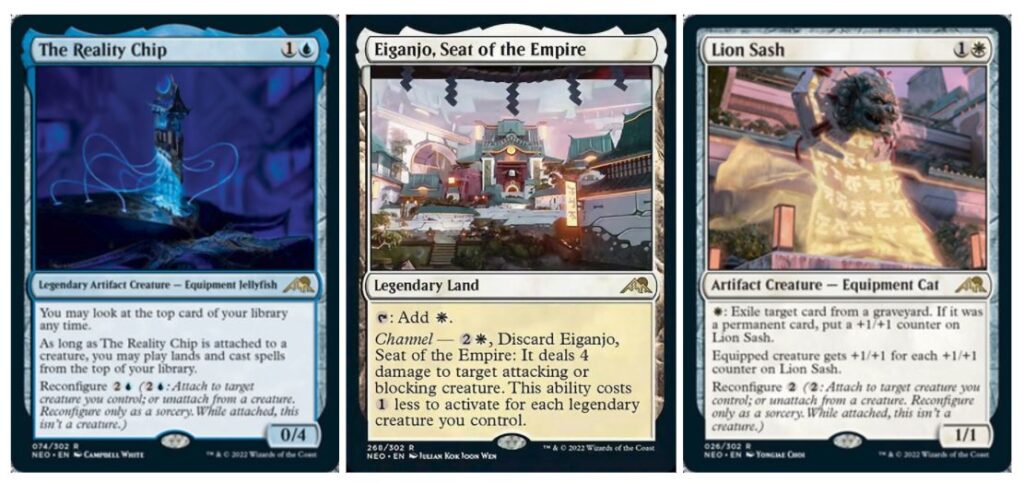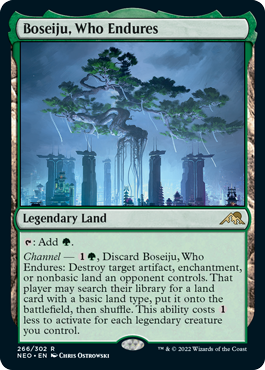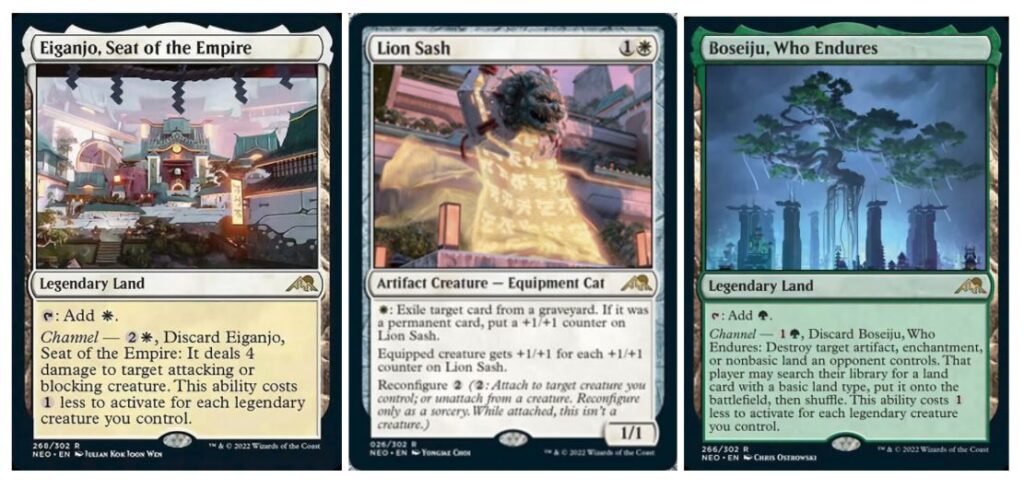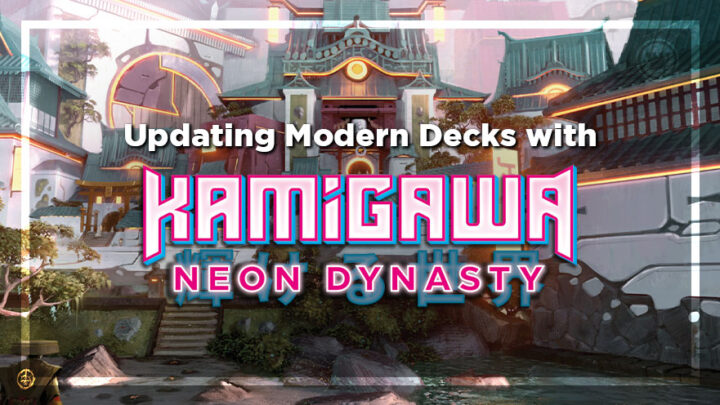Kamigawa: Neon Dynasty has only been legal on Magic Online for about two weeks at this point, and the hive mind is integrating new cards into decks faster than ever. By now, we have a solid idea which Neon Dynasty cards are going to make an impact in Modern: six unique cards have made enough appearances across nine different decks, which is much better than an average Standard set! I’ll be sharing those decks today and going over how they’ve changed and what you can expect at your next Modern tournament.
Hammer Time
Hammer Time may have gained the most from Neon Dynasty, with Eiganio, Seat of the Empire, The Reality Chip, and Lion Sash. While the deck only plays one copy of each of these cards, the artifacts are easy to tutor up thanks to Stoneforge Mystic. Previously, Hammer could only tutor for ways to deal more damage, which is great if the game is going their way. Now, Hammer can tutor for card advantage with The Reality Chip and graveyard hate with Lion Sash, making it a much more well-rounded deck.

Eiganio, Seat of the Empire isn’t blowing anyone away in Hammer by any means, but it does add a bit of depth to games. Traditionally, Hammer has been short on removal spells in game one, which makes being aggressive against them a viable strategy. However, Eiganjo will make players looking to get into combat with Hammer think just a bit more about their decisions.
Jund Saga
The only new card I’ve seen consistently in Jund Saga is Boseiju, Who Endures. That being said, Boseiju is a subtly powerful addition. Lands that can easily go to the graveyard, such as fetchlands, play well with Wrenn and Six, and Urza’s Saga has taught us that lands with spell effects that also go to the graveyard are incredibly powerful with the two-mana planeswalker.
Boseiju also provides an effect that Jund was sorely lacking in game one: the ability to interact with enchantments and lands. Boseiju combined with Wrenn and Six is going to bolster the Hammer Time and Tron match-ups in particular. While Jund has a positive Hammer match-up already, Boseiju is a low-cost way to gain additional equity. Tron, on the other hand, is historically a miserable match-up for Jund, because Jund can’t meaningfully interact in game one. Boseiju allows Jund to try and disrupt Tron’s mana, and while I don’t know if that’s enough to flip the match-up, it certainly is a welcome addition.

This version of the deck opts for Dragon’s Rage Channeler, but I could see a case for Elvish Reclaimer. Jund pilots have previously played Elvish Reclaimer to increase their access to Urza’s Saga. While tutoring for Boseiju with Elvish Reclaimer isn’t the fastest way to get the job done, you can sacrifice it to Reclaimer the following turn to pick it back up with Wrenn and Six.
Some players are also opting for a single copy of Expedition Map as a target for Urza’s Saga. Map can then find Boseiju to get the ball rolling.
Amulet Titan
Amulet Titan also picked up Boseiju from Neon Dynasty. While the deck may not have an engine like Wrenn and Six, Primeval Titan and Expedition Map can easily dig up Boseiju. Primeval Titan putting Boseiju into play would normally be problematic, but you can just find a bounce land alongside it to put it in your hand. Like the rest of the green decks on this list, Amulet Titan is happy to get some bonus points against Hammer. The biggest gain for Amulet is that Boseiju offers an uncounterable answer to Blood Moon, which is strong against Izzet Murktide.
Four-Color Blink
Four-Color Blink uses all parts of the buffalo – at least the ones we’ve covered already. Wrenn and Six allows Four-Color Blink to repeatedly pick up Boseiju for points against Hammer and Tron. Answers to Blood Moon are always appreciated in Four-Color Blink, as it is one of the best plans against the deck. However, finding Boseiju in an 80-card deck isn’t the easiest, especially when there is only one copy due to mana base concerns.
Crashing Footfalls
Crashing Footfalls gets to add a few copies of Boseiju relatively safely. While the deck doesn’t have Wrenn and Six – or any way to tutor – Boseiju still earns a spot as a clean answer to Engineered Explosives and Chalice of the Void, which can occasionally cause problems in game one.
While on the topic of Footfalls, I would expect the deck to pick up Otawara, Soaring City at some point as a strong answer to Teferi, Time Raveler, and other troublesome cards, like Thalia, Guardian of Thraben.
Izzet Murktide
Meanwhile, Izzet Murktide has already picked up the new blue land. Expressive Iteration, Consider and Mishra’s Bauble all aid in finding Otawara, which can team up with a Counterspell to stop a Teferi, Time Raveler. Bouncing an opposing Murktide Regent in the mirror isn’t too shabby, either. Izzet Murktide plays a low land count, as tempo decks often do, and getting extra utility out of lands is important to prevent flooding. I’d expect to see at least one copy become stock for a while to come.
Living End
Living End also gets access to Otawara, Soaring City, which answers a lot of problems. Chalice of the Void, Rest in Peace, Teferi, Time Raveler, and Thalia, Guardian of Thraben are all no match for Otawara, so Living End can untap and cascade away!

The other sneaky good pickup is Colossal Skyturtle. Let’s take a peek at its job description: It’s green for Force of Vigor and Endurance. It’s blue for Force of Negation and Subtlety. It bounces a laundry list of problem permanents, and it can pick up a cascade spell, should the previous Living End get answered. The best part is that both channel abilities put a big body in the graveyard! Colossal Skyturtle seems to be tailor-made for Living End.
Azorius Control
Azorius Control joins the Otawara, Soaring City club. This deck is always interested in flexible answers, and Otawara is about as flexible as they come. Just like the tempo decks we covered earlier, control decks enjoy spell effects tied to lands so they can prevent flooding. This specific list has one copy of Otawara, and I’d be careful not to include too many copies because it’s legendary. That said, this deck could easily play two or more copies.
Selesnya Death and Taxes
Selesnya may make the best use of Boseiju outside of Wrenn and Six decks. Combining Boseiju with Leonin Arbiter mitigates the downside of Boseiju almost entirely. Eiganjo adds another piece of disruption that also functions as a land when it needs to. Stoneforge Mystic finds Lion Sash, which gives Selesnya Death and Taxes some main-deck-playable graveyard hate – something the deck lacked before.

Kamigawa: Neon Dynasty has certainly made an impact on Modern, and in a healthy way. I’m always a fan of lands that do more than just make mana, because it tends to lead to smoother gameplay with more decisions. I’m excited to see where Modern goes from here, as players continue to explore Neon Dynasty in new ways. As always, I’m available on Twitter at @RappaciousOne for any questions or comments!

Michael Rapp is a Modern specialist who favors Thoughtseize decks. Magic sates his desire for competition and constant improvement.

